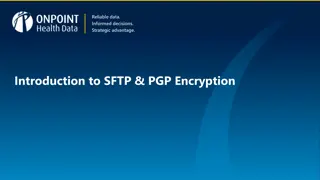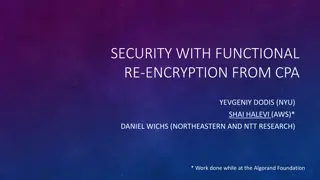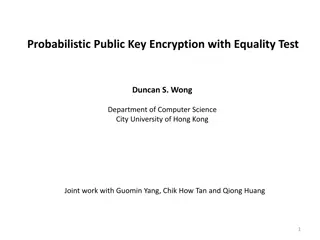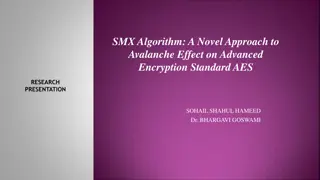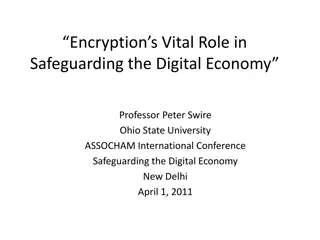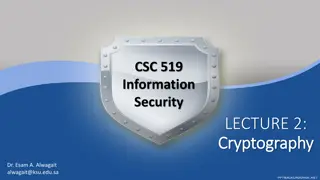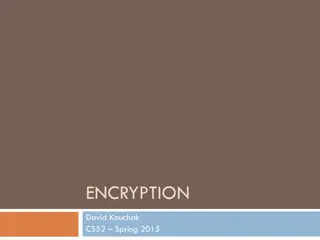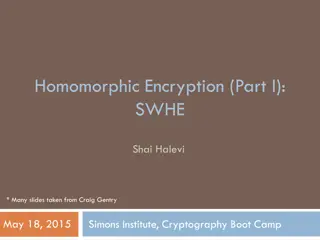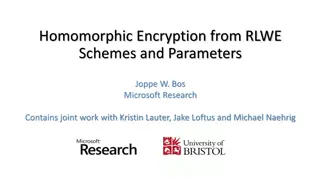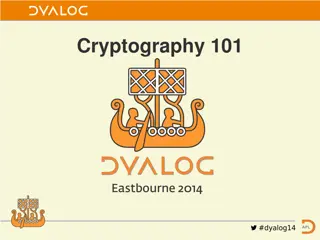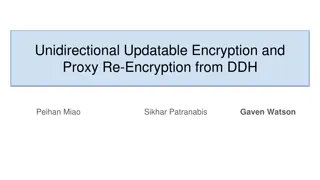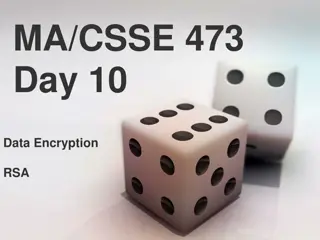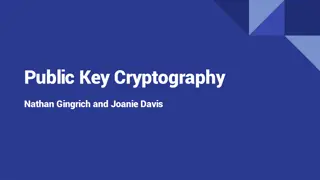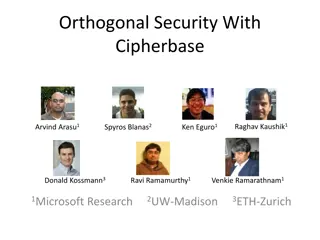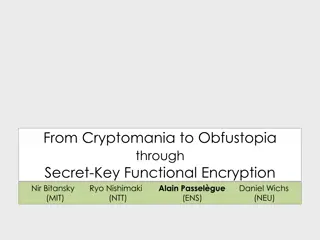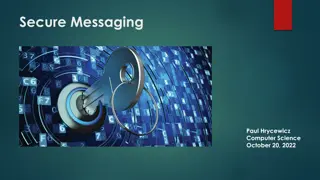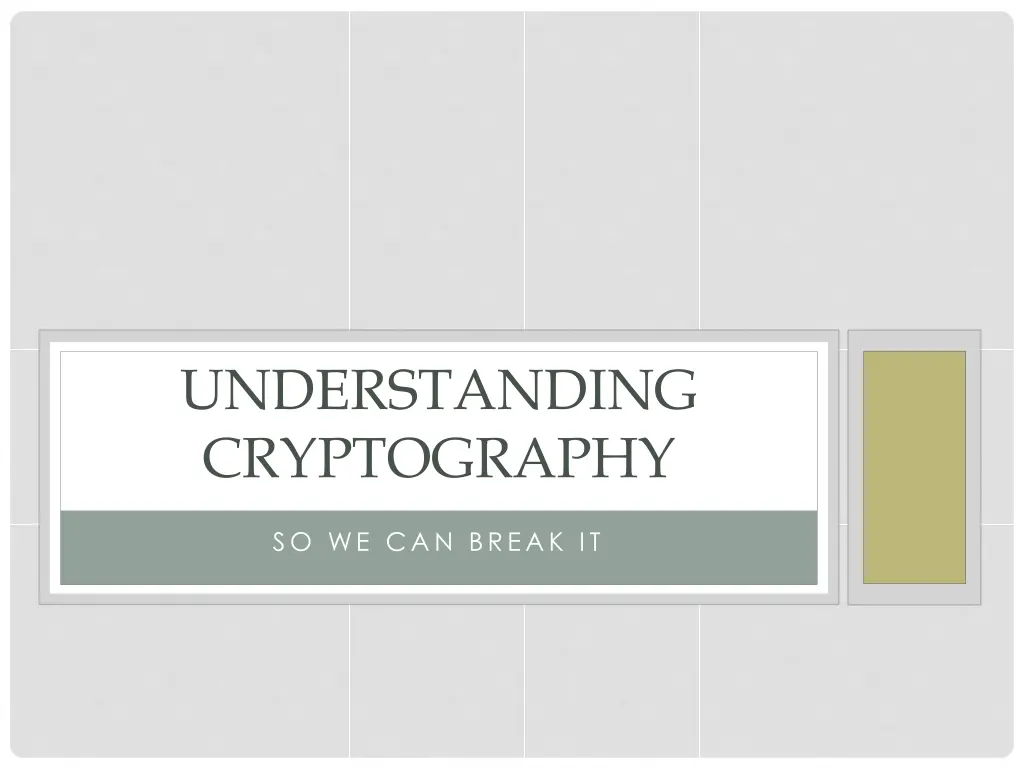
Breaking Down Cryptography for Understanding
Dive into the world of cryptography to decipher its complexities and unlock the secrets behind block and stream ciphers, block modes of operation, and encryption examples. Explore the differences between block and stream ciphers, modes like Electronic Code Book and Cipher Block Chaining, and witness text transformations from plain to ciphered text. Unravel the mysteries of cryptography and enhance your knowledge of data encryption methods.
Download Presentation

Please find below an Image/Link to download the presentation.
The content on the website is provided AS IS for your information and personal use only. It may not be sold, licensed, or shared on other websites without obtaining consent from the author. If you encounter any issues during the download, it is possible that the publisher has removed the file from their server.
You are allowed to download the files provided on this website for personal or commercial use, subject to the condition that they are used lawfully. All files are the property of their respective owners.
The content on the website is provided AS IS for your information and personal use only. It may not be sold, licensed, or shared on other websites without obtaining consent from the author.
E N D
Presentation Transcript
UNDERSTANDING CRYPTOGRAPHY SO WE CAN BREAK IT
BLOCK VS STREAM Generally, ciphers come in two forms: Block cipher Stream cipher Block ciphers convert data in n bit blocks Output is a fixed length Stream ciphers convert data one byte at a time Output is the same length as input
BLOCK CIPHERS To actually encrypt or decrypt a message requires a mode of operation such as: Electronic code book mode (ECB) *simplest Cipher Block Chaining (CBC) and others Examples of ECB could be: Caesar cipher with 1-character blocks" Or generally, everything that has a code book.
FOR EXAMPLE Plain Text: D E C A F A G F E D C E G A Cypher Text: A A B C D E F G H B B C D E F G H A C C D E F G H A B D D E F G H A B C E E F G H A B C D F F G H A B C D E G G H A B C D E F H H A B C D E F G A B C D E F G H
FOR EXAMPLE Plain Text: D E C A F A G F E D C E G A Cypher Text: A A B C D E F G H B B C D E F G H A C C D E F G H A B D D E F G H A B C E E F G H A B C D F F G H A B C D E G G H A B C D E F H H A B C D E F G A B C D E F G H
FOR EXAMPLE Plain Text: D E C A F A G F E D C E G A Cypher Text: A A B C D E F G H B B C D E F G H A C C D E F G H A B D D E F G H A B C E E F G H A B C D F F G H A B C D E G G H A B C D E F H H A B C D E F G A B C D E F G H
FOR EXAMPLE Plain Text: D E C A F A G F E D C E G A Cypher Text: D A A B C D E F G H B B C D E F G H A C C D E F G H A B D D E F G H A B C E E F G H A B C D F F G H A B C D E G G H A B C D E F H H A B C D E F G A B C D E F G H
FOR EXAMPLE Plain Text: D E C A F A G F E D C E G A Cypher Text: D C A A B C D E F G H B B C D E F G H A C C D E F G H A B D D E F G H A B C E E F G H A B C D F F G H A B C D E G G H A B C D E F H H A B C D E F G A B C D E F G H
FOR EXAMPLE Plain Text: D E C A F A G F E D C E G A Cypher Text: D C H A A B C D E F G H B B C D E F G H A C C D E F G H A B D D E F G H A B C E E F G H A B C D F F G H A B C D E G G H A B C D E F H H A B C D E F G A B C D E F G H
FOR EXAMPLE Plain Text: D E C A F A G F E D C E G A Cypher Text: D C H E A A B C D E F G H B B C D E F G H A C C D E F G H A B D D E F G H A B C E E F G H A B C D F F G H A B C D E G G H A B C D E F H H A B C D E F G A B C D E F G H
FOR EXAMPLE Plain Text: D E C A F A G F E D C E G A Cypher Text: D C H E A A A B C D E F G H B B C D E F G H A C C D E F G H A B D D E F G H A B C E E F G H A B C D F F G H A B C D E G G H A B C D E F H H A B C D E F G A B C D E F G H
FOR EXAMPLE Plain Text: A G F E D C E G A Cypher Text: D C H E A A A B C D E F G H B B C D E F G H A C C D E F G H A B D D E F G H A B C E E F G H A B C D F F G H A B C D E G G H A B C D E F H H A B C D E F G A B C D E F G H
FOR EXAMPLE Plain Text: D A G F E D C E G A Cypher Text: D C H E A A A B C D E F G H B B C D E F G H A C C D E F G H A B D D E F G H A B C E E F G H A B C D F F G H A B C D E G G H A B C D E F H H A B C D E F G A B C D E F G H
FOR EXAMPLE Plain Text: D E A G F E D C E G A Cypher Text: D C H E A A A B C D E F G H B B C D E F G H A C C D E F G H A B D D E F G H A B C E E F G H A B C D F F G H A B C D E G G H A B C D E F H H A B C D E F G A B C D E F G H
FOR EXAMPLE Plain Text: D E C A G F E D C E G A Cypher Text: D C H E A A A B C D E F G H B B C D E F G H A C C D E F G H A B D D E F G H A B C E E F G H A B C D F F G H A B C D E G G H A B C D E F H H A B C D E F G A B C D E F G H
FOR EXAMPLE Plain Text: D E C A A G F E D C E G A Cypher Text: D C H E A A A B C D E F G H B B C D E F G H A C C D E F G H A B D D E F G H A B C E E F G H A B C D F F G H A B C D E G G H A B C D E F H H A B C D E F G A B C D E F G H
FOR EXAMPLE Plain Text: D E C A F A G F E D C E G A Cypher Text: D C H E A A A B C D E F G H B B C D E F G H A C C D E F G H A B D D E F G H A B C E E F G H A B C D F F G H A B C D E G G H A B C D E F H H A B C D E F G A B C D E F G H
STREAM CIPHER Maps k-bit keys and arbitrary length plaintexts to same arbitrary length ciphertext If a part of the plaintext repeats, the corresponding ciphertext is not the same Different parts of the message will be encrypted in different ways. See the German Enigma machine Stream ciphers can be: Synchronous stream ciphers Asynchronous stream ciphers
TLDR Block Stream Block Cipher Converts the plain text into cipher text by taking plain text s block at a time. Block cipher uses either 64 bits or more than 64 bits. In block cipher, reverse encrypted text is hard. Stream Cipher Converts the plaint text into cipher text by taking 1 byte of plain text at a time. Stream cipher uses 8 bits. While in stream cipher, reverse encrypted text is easy.
INITIALIZATION VECTOR Also known as a Starting Variable a fixed-size input to a cryptographic function typically required to be random or pseudorandom Randomization is crucial for encryption Keeps attackers from working out patterns For block ciphers, the use of an IV is required by most modes of operation If the IV is non-repeating, the IV is commonly called a nonce (number used once)
IVs ARE NOT SECRET This is because the IV may be derived from a common state A fancy way of saying that the IV is often derived from the message
KEYS VS IVS A key is something you keep secret. Anyone who knows your key can decrypt any data you've encrypted with it Symmetric key cryptography Anyone with the private key can work out the public key Asymmetric key cryptography An IV or initialization vector is just the initial value used to start some iterated process
AES ENCRYPTION Advanced Encryption Standard Block cipher Became a federal government standard on May 26, 2002 The first and only publicly accessible cipher approved by the National Security Agency
FEATURES Symmetric key symmetric block cipher 128-bit data, 128/192/256-bit keys Stronger and faster than Triple-DES Provide full specification and design details Software implementable in C and Java
ROUNDS Each round has 4 subprocesses Byte Substitution (SubBytes) Shiftrows MixColumns Addroundkey
MODES OF OPERATION ECB mode: Electronic Code Book mode CBC mode: Cipher Block Chaining mode CFB mode: Cipher FeedBack mode OFB mode: Output FeedBack mode CTR mode: Counter mode https://www.highgo.ca/2019/08/08/the-difference- in-five-modes-in-the-aes-encryption-algorithm/
RSA ENCRYPTION Asymmetric Encryption Two keys Public Private Assumes finding the prime factors of a large composite number is difficult
HOW DOES IT WORK? 1. Choose two different large prime numbers: p and q 2. Calculate n = pq 3. Calculate the totient: T=(p-1)(q-1) 4. Choose an integer e such that 1 < e < T(n) and e shares no factors other than 1 with T(n) 1. eis coprime with T(n) 5. Compute d so that the relation de 1 6. e is released as the public key exponent 7. d is kept as the private key exponent
ENCRYPTION Alice gives her public key n & e to Bob and keeps her private key secret. Bob wants to send message M to Alice. First he turns M into a number m smaller than n by using an agreed-upon reversible protocol known as a padding scheme. He then computes the ciphertext c ? = ?? ???(?)
DECRYPTION Alice can recover m from c by using her private key d in the following procedure: ? = ?? ??? ? Given m, she can recover the original distinct prime numbers, applying the Chinese remainder theorem to these two congruences yields
Choose two random prime numbers p = 61 q = 53 Compute n n =?
Choose two random prime numbers p = 61 q = 53 Compute n n = (61 * 53) = 3233
p = 61, q = 53, n = 3233 Compute the totient T = (p-1)(q-1) = ?
p = 61, q = 53, n = 3233 Compute the totient T = (p-1)(q-1) = 3120 Choose e > 1 and coprime to 3120 e = 17
p = 61, q = 53, n = 3233, T(n) = 3120, e = 17 Choose d to satisfy ?? ???(? ? ) 1 d =?
p = 61, q = 53, n = 3233, T(n) = 3120, e = 17 Choose d to satisfy ?? ???(? ? ) 1 d = 2753
Public key: n = 3233, e = 17 Private key: n = 3233, d = 2753
DECRYPT THE FOLLOWING 2557 What happens when you try to encrypt/decrypt 8192?
NOW THEN RSA relies on not being able to factor n into prime factors. (3233) is easy for a computer RSA keys are typically 1024, 2048, or 4096 bits in length, so we use two primes of approximately half that length each Most modern uses are typically 2048 or 4096 as factoring 1024-bit semiprimes is difficult but feasible RSA gets its strength from the difficulty in figuring out which prime numbers were used. So don t just use a list of large prime numbers
SO How do we get large prime numbers without using a list?
SO How do we get large prime numbers without using a list? wait for it



